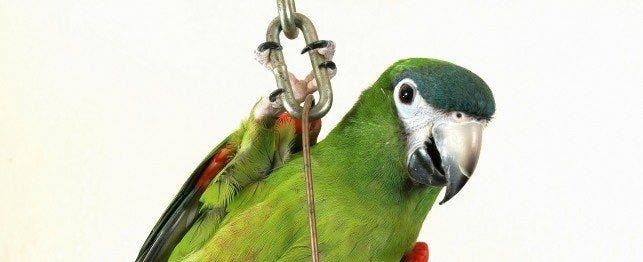
Choosing a Noble’s Macaw
Noble’s macaws are very inquisitive, mischievous and animated. They are delightful pets because of their outgoing personalities. Macaws can make excellent pets, although some have a tendency to become nippy. Mini macaws are not as loud as the large macaws. While some speak, most macaws have limited ability to mimic. Noble’s macaws are relatively quiet.
Noble’s macaws are found in open wooded habitats with palms. They are common in South America and usually found in pairs or small flocks. They feed on locally available fruits; especially palm nut fruits, seeds, nuts and buds. They nest in cavities of dead trees, termite nests or in holes in living palms.
Noble’s macaws can live up to 30 years.
Appearance and Personality
Noble’s macaws are the smallest macaws and closely resemble the Aratinga conures. They are distinguished from the other “mini” macaws by size, their green, rather than blue flight feathers, and the bright red shoulder patch. The forehead is blue-green. The naked facial skin is small, white and has rows of black feather forming lines. The tail is long, tapered, and green. Mini macaws are lively boisterous birds and require generous living space.
Young hand-raised macaws are very adaptable and typically easily handled by many people. They must be socialized and exposed to a variety of experiences (veterinary visits, other pets, visitors, wing and nail trims, car rides, etc.) at a young age to avoid fearful behavior.
Macaws are playful and love to chew. They should always be provided with toys, especially wooden blocks that can be chewed, and branches from non-toxic trees. In order to ensure safety companion macaws should not be allowed unsupervised freedom in the home as they often encounter toxins or dangerous items. Young macaws should be socialized to many people and exposed to a variety of situations such as new cages, toys, visits to the veterinarian, handling by friends, wing and nail clips, etc. to avoid fear of novel situations.
Feeding
All macaws need plenty of energy for good health. Many of their natural foods, especially palm nuts are rich in oils, and calories. Macaws should be fed a formulated (pelleted or extruded) diet as a basis for good nutrition. The diet should be supplemented with fresh fruits and vegetables daily to add variety and psychological enrichment. Feed approximately 1/6 cup pellets daily. Also offer 1/6 cup of fresh fruits and vegetables. Give 1 to 2 small nuts such as almonds for treats. Small amounts of seed may also be given as treats especially as rewards for good behavior. Vitamin supplements are not needed for birds that are eating a formulated diet.
Noble’s macaws are difficult to hand feed from a very early age. They require a high fat diet and do well with additional protein as well especially at a very young age. A small amount of peanut butter or ground sunflower seeds may be added to increase protein and fat levels.
Grooming
Routine bathing or showering is vital to maintaining good plumage and skin condition. Birds can be misted and allowed to dry in a warm room or in the sun, or dried with a blow drier. An ideal way to bathe macaws is to put them in a cage outside, sprinkle them with the hose, and allow them to dry in the sun. Macaws are strong fliers. Most of the primary flight feathers (10 feathers closest to the tip of the wing) should be clipped to prevent flight. Clip only enough so the bird will glide to the floor.
Housing
Macaws are very active and should be provided the largest cage that space and budget allows. Mini macaws can be kept in a moderate sized cage in the home. Macaws should have adequate space to move freely between two perches. An example of an appropriate suspended cage size for Noble’s macaws is 3 feet by 3 feet by 6 feet. Cages should be suspended 3 to 4 feet above the ground.
Cages for Noble’s macaws can be kept in wire suitable for conures. Use 14 gauge welded wire, 1-inch by 1-inch or 1/2 inch by 1 inch for most pairs. Locks or escape proof latches may be necessary on cages. Ideally pet macaws can also have a large cage outdoors for bathing and exercise.
Breeding
Noble’s macaws breed fairly well in captivity. Breeding season is usually in spring and early summer, although some pairs will breed almost year round. Clutch size is usually two to four eggs but sometimes more. Incubation period is 23 to 26 days. Some additional high fat seeds, like sunflower seed, should be added to the diet during the breeding season to stimulate reproduction. Inexperienced hand feeders should allow the parents to feed for the first few weeks.
Noble’s macaws like vertical wooden box (about 12 inches by 12 inches by 24 inches). Macaws should be provided with plentiful chewing material. Pine shavings make excellent nest box bedding.
Mate aggression is uncommon in macaws. Pair bonds are strong but not necessarily life long.
Common Diseases and Disorders
Macaws are relatively healthy birds but are susceptible to the following:
- Proventricular Dilatation Disease (Macaw wasting disease)
- Feather picking
- Psittacosis (chlamydiosis)
- Bacterial, viral and fungal infections
- Pancreatitis
- Kidney Disease – gout
- Toxicity, heavy metal poisoning
- Chewing flight and tail feathers by juveniles